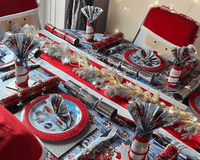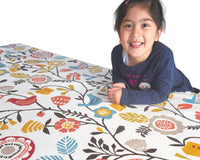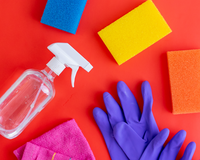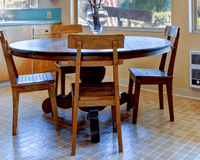Our table protectors are made from specialised materials designed to resist heat to some degree—think warm plates and cups—but they are not built to handle the intense, direct, sustained heat of an iron.
Most table protectors are heat-resistant only up to a certain point, usually around 100 degrees. An iron, on the other hand, can easily exceed 180°C even on low settings making the two incompatible.
Here’s what can go wrong if you try ironing your table protector directly:
-
Melting or Warping: The heat can distort, melt, or warp the PVC layer. Instead of smoothing it out, you’ll likely create permanent bubbles, ridges or even holes.
-
Sticking to the Iron: Melted plastic or vinyl can adhere to the soleplate of your iron, ruining both your protector and the iron itself.
-
Staining: If your table protector has a printed design, the heat may cause inks or dyes to bleed or transfer, permanently damaging the pattern.
-
Releasing Fumes: Heated plastics can release unpleasant, potentially harmful fumes—not what you want in your kitchen or dining area.
At Table Protector Direct, we want you to get the longest life out of your table protector, which is why we advise against ironing them in any circumstance.

How to Deal with Creases in Your Table Protector
We understand why customers ask about ironing. While you shouldn’t iron them, there are effective, safe methods to reduce or remove these lines that may occur from folding the protector:
1. Let It Relax Naturally
The easiest (and safest) approach is simply to lay your table protector flat on your table and let gravity do the work. Over a few days to a couple of weeks, most ridges will relax on their own, especially in a warm room.
At Table Protector Direct, we recommend this as the first step for any new protector.
2. Use Gentle Heat—But Not Direct!
If you’re impatient to smooth things out, you can carefully apply indirect heat:
-
Place the protector flat on your table.
-
Turn the protector over so that you have the reverse facing up and place a towel on top. Do not iron on the top side.
-
Gently run an iron at a low heat over the towel on the creased area to help remove the fold lines quickly.
This softens the material just enough to encourage it to relax without risking damage.
3. Warm Sunlight
On a sunny day, laying your table protector in direct sunlight for an hour or two can help. The gentle warmth softens the PVC or oilcloth slightly, allowing creases to flatten.
4. Weighted Flattening
For persistent creases, try laying the protector flat and placing books or other evenly-distributed weights on top overnight. The steady pressure helps smooth out stubborn folds.
Are Any Table Protectors Safe for Ironing?
It’s worth noting that some specialist products, like certain heat-proof ironing mats, are designed to be ironed on. These are made from heat-resistant silicone or heavy-duty cotton batting specifically to withstand direct ironing temperatures.
However, these are entirely different products from typical table protectors. Our oilcloth and wipe-clean tablecloths are designed for dining tables, craft tables, or work surfaces, but not for use as ironing boards.
If you need an ironing-safe surface, your best option is to buy a purpose-built ironing pad or board.
Care Tips for Your Table Protector
Since ironing is off the table (quite literally), how can you keep your table protector looking its best? Here are a few simple care guidelines:
-
Clean regularly with a soft cloth and warm soapy water. Avoid harsh scrubbing or abrasive cleaners that can scratch the surface.
-
Avoid sharp objects that might gouge or cut the surface.
-
Store flat or loosely rolled if you need to put it away—tight rolling can create more stubborn creases. We offer a rolled delivery option at the checkout to avoid any fold lines, however it is generally not required.
-
Don’t expose to direct flame or extreme heat—while they’re heat-resistant for everyday dining, they are not fireproof.
By following these tips, you’ll keep your table protector in excellent condition for years of family meals, homework sessions, and entertaining.

Why Buy from Table Protector Direct?
At Table Protector Direct, we specialise in high-quality, UK-made table protectors and oilcloth tablecloths designed to suit every home. Our range includes:
-
Custom-cut protectors for unusual table shapes (even if you need to provide a DXF file!)
-
Dozens of designs from modern geometrics to classic florals
-
Durable, wipe-clean finishes for busy households
We pride ourselves on offering expert guidance and unbeatable quality. And part of that expert advice is always giving you the truth—even when it’s simply “No, don’t iron on your table protector.”
Final Answer: Can You Iron on Your Table Protector?
To wrap it up clearly: No—you can’t and shouldn’t iron directly on your table protector.
Ironing can cause irreversible damage, ruin the finish, and shorten the life of your investment. Instead, use safe, gentle methods to smooth out any creases and enjoy the practical, stylish protection our products offer.
For more advice, tips, or to explore our full range, visit Table Protector Direct today. We’re always happy to help you find the perfect solution for your table!












